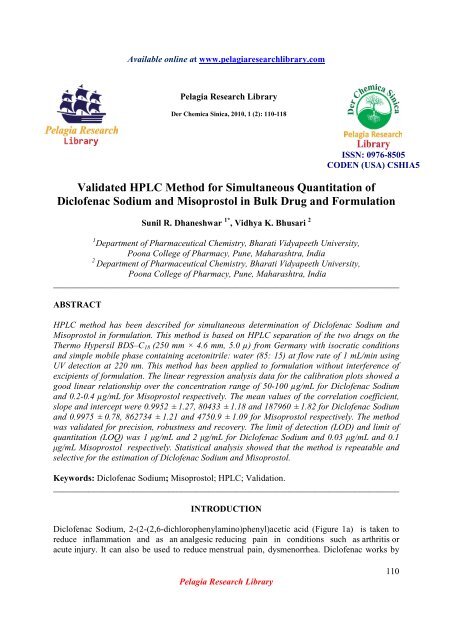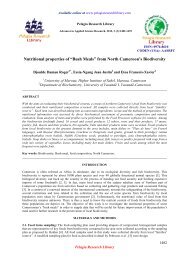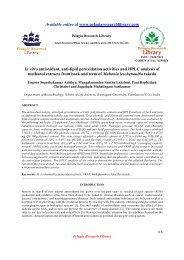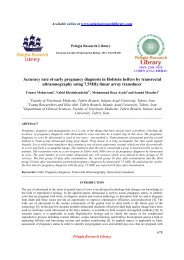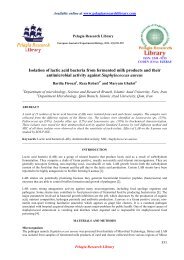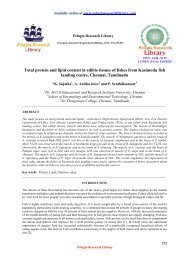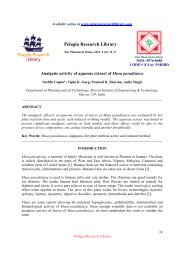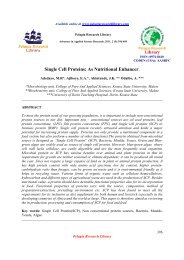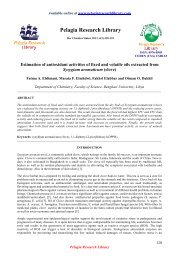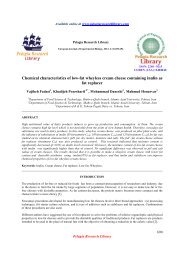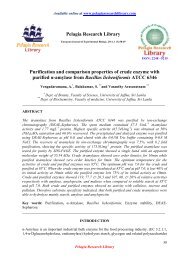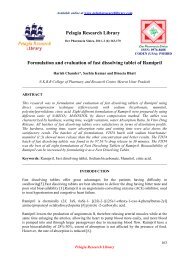Validated HPLC Method for Simultaneous Quantitation of Diclofenac ...
Validated HPLC Method for Simultaneous Quantitation of Diclofenac ...
Validated HPLC Method for Simultaneous Quantitation of Diclofenac ...
You also want an ePaper? Increase the reach of your titles
YUMPU automatically turns print PDFs into web optimized ePapers that Google loves.
Available online at www.pelagiaresearchlibrary.com<br />
Pelagia Research Library<br />
Der Chemica Sinica, 2010, 1 (2): 110-118<br />
ISSN: 0976-8505<br />
CODEN (USA) CSHIA5<br />
<strong>Validated</strong> <strong>HPLC</strong> <strong>Method</strong> <strong>for</strong> <strong>Simultaneous</strong> <strong>Quantitation</strong> <strong>of</strong><br />
Dicl<strong>of</strong>enac Sodium and Misoprostol in Bulk Drug and Formulation<br />
Sunil R. Dhaneshwar 1* , Vidhya K. Bhusari 2<br />
1 Department <strong>of</strong> Pharmaceutical Chemistry, Bharati Vidyapeeth University,<br />
Poona College <strong>of</strong> Pharmacy, Pune, Maharashtra, India<br />
2<br />
Department <strong>of</strong> Pharmaceutical Chemistry, Bharati Vidyapeeth University,<br />
Poona College <strong>of</strong> Pharmacy, Pune, Maharashtra, India<br />
______________________________________________________________________________<br />
ABSTRACT<br />
<strong>HPLC</strong> method has been described <strong>for</strong> simultaneous determination <strong>of</strong> Dicl<strong>of</strong>enac Sodium and<br />
Misoprostol in <strong>for</strong>mulation. This method is based on <strong>HPLC</strong> separation <strong>of</strong> the two drugs on the<br />
Thermo Hypersil BDS–C 18 (250 mm × 4.6 mm, 5.0 µ) from Germany with isocratic conditions<br />
and simple mobile phase containing acetonitrile: water (85: 15) at flow rate <strong>of</strong> 1 mL/min using<br />
UV detection at 220 nm. This method has been applied to <strong>for</strong>mulation without interference <strong>of</strong><br />
excipients <strong>of</strong> <strong>for</strong>mulation. The linear regression analysis data <strong>for</strong> the calibration plots showed a<br />
good linear relationship over the concentration range <strong>of</strong> 50-100 µg/mL <strong>for</strong> Dicl<strong>of</strong>enac Sodium<br />
and 0.2-0.4 µg/mL <strong>for</strong> Misoprostol respectively. The mean values <strong>of</strong> the correlation coefficient,<br />
slope and intercept were 0.9952 ± 1.27, 80433 ± 1.1 8 and 187960 ± 1.82 <strong>for</strong> Dicl<strong>of</strong>enac Sodium<br />
and 0.9975 ± 0.78, 862734 ± 1.21 and 4750.9 ± 1.09 <strong>for</strong> Misoprostol respectively. The method<br />
was validated <strong>for</strong> precision, robustness and recovery. The limit <strong>of</strong> detection (LOD) and limit <strong>of</strong><br />
quantitation (LOQ) was 1 µg/mL and 2 µg/mL <strong>for</strong> Dicl<strong>of</strong>enac Sodium and 0.03 µg/mL and 0.1<br />
µg/mL Misoprostol respectively. Statistical analysis showed that the method is repeatable and<br />
selective <strong>for</strong> the estimation <strong>of</strong> Dicl<strong>of</strong>enac Sodium and Misoprostol.<br />
Keywords: Dicl<strong>of</strong>enac Sodium; Misoprostol; <strong>HPLC</strong>; Validation.<br />
______________________________________________________________________________<br />
INTRODUCTION<br />
Dicl<strong>of</strong>enac Sodium, 2-(2-(2,6-dichlorophenylamino)phenyl)acetic acid (Figure 1a) is taken to<br />
reduce inflammation and as an analgesic reducing pain in conditions such as arthritis or<br />
acute injury. It can also be used to reduce menstrual pain, dysmenorrhea. Dicl<strong>of</strong>enac works by<br />
Pelagia Research Library<br />
110
Sunil R. Dhaneshwar et al Der Chemica Sinica, 2010, 1 (2): 110-118<br />
______________________________________________________________________________<br />
inhibiting prostaglandin synthesis by inhibition <strong>of</strong> cyclooxygenase (COX), inhibiting DNA<br />
synthesis. [1]<br />
Cl<br />
Cl<br />
N<br />
H<br />
O Na +<br />
Figure 1(a) Structure <strong>of</strong> Dicl<strong>of</strong>enac Sodium<br />
Misoprostol, methyl-7-((1R,2R,3R)-3-hydroxy-2-((S,E)-4-hydroxy-4-methyloct-1-enyl)-5-<br />
oxocyclopentyl)heptanoate (Figure 1b) is used <strong>for</strong> the prevention <strong>of</strong> non-steroidal antiinflammatory<br />
drug (NSAID) induced gastric ulcers, <strong>for</strong> early abortion, to treat missed<br />
miscarriage, and to induce labor. Misoprostol inhibits gastric acid secretion by a direct action on<br />
the parietal cells through binding to the prostaglandin receptor. The activity <strong>of</strong> this receptor is<br />
mediated by G proteins which normally activate adenylate cyclase. The indirect inhibition <strong>of</strong><br />
adenylate cyclase by Misoprostol may be dependent on guanosine-5-triphosphate (GTP). [2]<br />
O<br />
O<br />
COOCH 3<br />
HO<br />
C H 3<br />
OH<br />
Figure 1 (b) Structure <strong>of</strong> Misoprostol<br />
Literature review reveals that methods have been reported <strong>for</strong> analysis <strong>of</strong> Dicl<strong>of</strong>enac Sodium and<br />
Misoprostol, stability indicating <strong>HPLC</strong> method <strong>for</strong> Dicl<strong>of</strong>enac in raw materials and solid dosage<br />
<strong>for</strong>m [3], RP-<strong>HPLC</strong> method <strong>for</strong> determination <strong>of</strong> Dicl<strong>of</strong>enac in combination with other drugs [4,<br />
5, 6] and few bioanalytical methods are also reported [7, 8]. Stability Indicating <strong>HPLC</strong> Assay<br />
<strong>Method</strong> <strong>for</strong> Misoprostol [9], RP-<strong>HPLC</strong> method <strong>for</strong> determination <strong>of</strong> Misoprostol in combination<br />
with other drugs [10], HPTLC method <strong>for</strong> quantitation <strong>of</strong> Dicl<strong>of</strong>enac and Misoprostol in<br />
combination with other drugs is also reported.<br />
To date, there have been no published reports about the simultaneous quantitation <strong>of</strong> Dicl<strong>of</strong>enac<br />
Sodium and Misoprostol by <strong>HPLC</strong> in bulk drug and in tablet dosage <strong>for</strong>m. This present study<br />
reports <strong>for</strong> the first time simultaneous quantitation <strong>of</strong> Dicl<strong>of</strong>enac Sodium and Misoprostol by<br />
<strong>HPLC</strong> in bulk drug and in tablet dosage <strong>for</strong>m. The proposed method is validated as per ICH<br />
guidelines.<br />
Pelagia Research Library 111
Sunil R. Dhaneshwar et al Der Chemica Sinica, 2010, 1 (2): 110-118<br />
______________________________________________________________________________<br />
MATERIALS AND METHODS<br />
Materials<br />
Wockhardt Pharmaceuticals Ltd. Aurangabad, India, kindly supplied pure drug sample <strong>of</strong><br />
Dicl<strong>of</strong>enac Sodium as a gift sample <strong>of</strong> Batch No.: DS88654 and Misoprostol <strong>of</strong> Batch No.:<br />
MT11836. It was used without further purification and certified to contain 99.85 % (w/w) <strong>for</strong><br />
Dicl<strong>of</strong>enac Sodium and 99.92 % (w/w) <strong>for</strong> Misoprostol on dried basis. All chemicals and<br />
reagents used were <strong>of</strong> <strong>HPLC</strong> grade and were purchased from Merck Chemicals, India.<br />
Instrumentation<br />
The <strong>HPLC</strong> system consisted <strong>of</strong> a Pump (model Jasco PU 2080), Intelligent LC pump with<br />
sampler programmed at 20 µL capacity per injection was used. The detector consisted <strong>of</strong> UV/<br />
VIS (Jasco UV 2075) model operated at a wavelength <strong>of</strong> 220 nm. Data was integrated using<br />
Jasco Borwin version 1.5, LC-Net II/ADC system. The column used was Thermo Hypersil BDS–<br />
C 18 (250 mm × 4.6 mm, 5.0 µ) from Germany.<br />
Preparation <strong>of</strong> Standard Stock Solutions<br />
Standard stock solution <strong>of</strong> concentration 5000 µg/mL <strong>of</strong> Dicl<strong>of</strong>enac Sodium and 20 µg/mL <strong>of</strong><br />
Misoprostol was prepared using water. From the standard stock solution, the mixed standard<br />
solution were prepared using acetonitrile to contain 50 µg/mL <strong>of</strong> Dicl<strong>of</strong>enac Sodium and 0.2<br />
µg/mL <strong>of</strong> Misoprostol. The stock solution was stored at 2-8 °C protected from light.<br />
Optimization <strong>of</strong> <strong>HPLC</strong> <strong>Method</strong><br />
The <strong>HPLC</strong> procedure was optimized with a view to develop a simultaneous assay method <strong>for</strong><br />
Dicl<strong>of</strong>enac Sodium and Misoprostol respectively. The mixed standard stock solution (50 µg/mL<br />
<strong>of</strong> Dicl<strong>of</strong>enac Sodium and 0.2 µg/mL <strong>of</strong> Misoprostol) was injected in <strong>HPLC</strong>.<br />
For <strong>HPLC</strong> method optimization different ratios <strong>of</strong> acetonitrile and water were tried but it was<br />
found that acetonitrile: water in the ratio 85: 15 v/v, at flow rate 1 mL/min gives acceptable<br />
retention time (t R ), plates and good resolution <strong>for</strong> Dicl<strong>of</strong>enac Sodium and Misoprostol (Figure 2).<br />
Figure 2 <strong>HPLC</strong> chromatogram <strong>of</strong> standard Dicl<strong>of</strong>enac Sodium and Misoprostol (50 µg/mL<br />
and 0.2 µg/mL)<br />
Pelagia Research Library 112
Sunil R. Dhaneshwar et al Der Chemica Sinica, 2010, 1 (2): 110-118<br />
______________________________________________________________________________<br />
Validation <strong>of</strong> the method<br />
Validation <strong>of</strong> the optimized <strong>HPLC</strong> method was carried out with respect to the following<br />
parameters.<br />
Linearity and range<br />
The mixed standard stock solution (5000 µg/mL <strong>of</strong> Dicl<strong>of</strong>enac Sodium and 20 µg/mL <strong>of</strong><br />
Misoprostol) was further diluted to get Dicl<strong>of</strong>enac Sodium and Misoprostol concentration in the<br />
range <strong>of</strong> 50-100 µg/mL and 0.2-0.4 µg/mL respectively. Linearity <strong>of</strong> the method was studied by<br />
injecting six concentrations <strong>of</strong> the drug prepared in the mobile phase in triplicate into the LC<br />
system keeping the injection volume constant. The peak areas were plotted against the<br />
corresponding concentrations to obtain the calibration graphs.<br />
Precision<br />
The precision <strong>of</strong> the method was verified by repeatability and intermediate precision studies.<br />
Repeatability studies were per<strong>for</strong>med by analysis <strong>of</strong> three different concentrations 60, 80, 100<br />
µg/mL <strong>for</strong> Dicl<strong>of</strong>enac Sodium and 0.24, 0.32, 0.40 µg/mL <strong>for</strong> Misoprostol six times on the same<br />
day. The intermediate precision <strong>of</strong> the method was checked by repeating studies on three<br />
different days.<br />
Limit <strong>of</strong> detection and limit <strong>of</strong> quantitation<br />
Limits <strong>of</strong> detection (LOD) and quantification (LOQ) represent the concentration <strong>of</strong> the analyte<br />
that would yield signal-to-noise ratios <strong>of</strong> 3 <strong>for</strong> LOD and 10 <strong>for</strong> LOQ, respectively. To determine<br />
the LOD and LOQ, serial dilutions <strong>of</strong> mixed standard solution <strong>of</strong> Dicl<strong>of</strong>enac Sodium and<br />
Misoprostol was made from the standard stock solution. The samples were injected in LC system<br />
and measured signal from the samples was compared with those <strong>of</strong> blank samples.<br />
Robustness <strong>of</strong> the method<br />
To evaluate robustness <strong>of</strong> a <strong>HPLC</strong> method, few parameters were deliberately varied. The<br />
parameters included variation <strong>of</strong> flow rate, percentage <strong>of</strong> acetonitrile in the mobile phase and<br />
solvents from different lot were taken. Robustness <strong>of</strong> the method was done at three different<br />
concentration levels 60, 80, 100 µg/mL and 0.24, 0.32, 0.4 µg/mL <strong>for</strong> Dicl<strong>of</strong>enac Sodium and<br />
Misoprostol respectively.<br />
Specificity<br />
The specificity <strong>of</strong> the method towards the drug was established through study <strong>of</strong> resolution factor<br />
<strong>of</strong> the drug peak from the nearest resolving peak.The peak purity <strong>of</strong> Dicl<strong>of</strong>enac Sodium and<br />
Misoprostol was determined by comparing the spectrum at three different regions <strong>of</strong> the spot i.e.<br />
peak start (S), peak apex (M) and peak end (E). Effect <strong>of</strong> excipients <strong>of</strong> <strong>for</strong>mulation was studied<br />
<strong>for</strong> whether it interfered with the assay.<br />
Accuracy<br />
Accuracy <strong>of</strong> the method was carried out by applying the method to drug sample (Dicl<strong>of</strong>enac<br />
Sodium and Misoprostol combination tablet) to which know amount <strong>of</strong> Dicl<strong>of</strong>enac Sodium and<br />
Misoprostol standard powder corresponding to 80, 100 and 120 % <strong>of</strong> label claim had been added<br />
(Standard addition method), mixed and the powder was extracted and analyzed by running<br />
chromatogram in optimized mobile phase.<br />
Pelagia Research Library 113
Sunil R. Dhaneshwar et al Der Chemica Sinica, 2010, 1 (2): 110-118<br />
______________________________________________________________________________<br />
Analysis <strong>of</strong> a marketed <strong>for</strong>mulation<br />
To determine the content <strong>of</strong> Dicl<strong>of</strong>enac Sodium and Misoprostol in conventional tablet (Brand<br />
name: Arthrotec 50, Label claim: 50 mg Dicl<strong>of</strong>enac and 0.2 mg Misoprostol per tablet), twenty<br />
tablets were weighed, their mean weight determined and finely powdered. The weight <strong>of</strong> the<br />
tablet triturate equivalent to 50 mg <strong>of</strong> Dicl<strong>of</strong>enac Sodium and 0.2 mg Misoprostol was<br />
transferred into a 50 mL volumetric flask containing 30 mL water, sonicated <strong>for</strong> 30 min and<br />
diluted upto 50 mL with water. The resulting solution was centrifuged at 3000 rpm <strong>for</strong> 5 min and<br />
the drug content <strong>of</strong> the supernatant was determined (1000 and 4 µg/mL <strong>for</strong> Dicl<strong>of</strong>enac Sodium<br />
and Misoprostol respectively). Supernatant was taken and after suitable dilution the sample<br />
solution was then filtered using 0.45-micron filter (Millipore, Mil<strong>for</strong>d, MA). The above stock<br />
solution was further diluted to get sample solution <strong>of</strong> 50 and 0.2 µg/mL <strong>for</strong> Dicl<strong>of</strong>enac Sodium<br />
and Misoprostol respectively. A 20 µl volume <strong>of</strong> sample solution was injected into <strong>HPLC</strong>, six<br />
times, under the conditions described above. The peak areas were measured at 220 nm and<br />
concentrations in the samples were determined using multilevel calibration developed on the<br />
same <strong>HPLC</strong> system under the same conditions using linear regression equation.<br />
RESULTS AND DISCUSSION<br />
The results <strong>of</strong> validation studies on simultaneous estimation method developed <strong>for</strong> Dicl<strong>of</strong>enac<br />
Sodium and Misoprostol in the current study involving acetonitrile: water (85: 15, v/v) are given<br />
below.<br />
Concentration<br />
(µg/mL)<br />
Table I : Precision studies<br />
Measured concentration ± SD, RSD (%)<br />
Repeatability<br />
(n= 6)<br />
Intermediate precision<br />
(n= 6)<br />
Dicl<strong>of</strong>enac Sodium<br />
60 59.229 ± 95406, 1.926 59.985 ± 76634, 1.528<br />
80 78.586 ± 59108, 0.908 79.189 ± 76837, 1.170<br />
100 98.258 ± 77023, 0.951 98.018 ± 106690, 1.321<br />
Misoprostol<br />
0.24 0.243 ± 899, 0.419 0.244 ± 1985, 0.919<br />
0.32 0.325 ± 2985, 1.045 0.325 ± 2177, 0.763<br />
0.40 0.406 ± 3165, 0.899 0.404 ± 2348, 0.664<br />
Linearity<br />
Dicl<strong>of</strong>enac Sodium and Misoprostol showed good correlation coefficient (r 2 = 0.9952 <strong>for</strong><br />
Dicl<strong>of</strong>enac Sodium and 0.9975 <strong>for</strong> Misoprostol) in given concentration range (50-100 µg/mL <strong>for</strong><br />
Dicl<strong>of</strong>enac Sodium and 0.20-0.40 µg/mL <strong>for</strong> Misoprostol). The mean values <strong>of</strong> the slope and<br />
Pelagia Research Library 114
Sunil R. Dhaneshwar et al Der Chemica Sinica, 2010, 1 (2): 110-118<br />
______________________________________________________________________________<br />
intercept were 80433 ± 1.18 and 187960 ± 1.82 <strong>for</strong> Dicl<strong>of</strong>enac Sodium and 862734 ± 1.21 and<br />
4750.9 ± 1.09 <strong>for</strong> Misoprostol respectively.<br />
Precision<br />
The results <strong>of</strong> the repeatability and intermediate precision experiments are shown in Table I. The<br />
developed method was found to be precise as the RSD values <strong>for</strong> repeatability and intermediate<br />
precision studies were < 2 %, respectively as recommended by ICH guidelines.<br />
LOD and LOQ<br />
Signal-to-noise ratios <strong>of</strong> 3:1 and 10:1 were obtained <strong>for</strong> the LOD and LOQ respectively. The<br />
LOD and LOQ were found to be 1 µg/mL and 2 µg/mL <strong>for</strong> Dicl<strong>of</strong>enac Sodium and 0.03 µg/mL<br />
and 0.1 µg/mL Misoprostol respectively.<br />
Robustness <strong>of</strong> the method<br />
Each factor selected (except columns from different manufacturers) was changed at three levels<br />
(−1, 0 and 1). One factor at the time was changed to estimate the effect. Thus, replicate injections<br />
(n = 6) <strong>of</strong> mixed standard solution at three concentration levels were per<strong>for</strong>med under small<br />
changes <strong>of</strong> three chromatographic parameters (factors). Insignificant differences in peak areas<br />
and less variability in retention time were observed (Table II).<br />
Table II: Robustness testing a (n = 3)<br />
Factor a Level Retention<br />
time<br />
Dicl<strong>of</strong>enac Sodium<br />
Retention<br />
factor<br />
Asymmetry<br />
A: Flow rate (mL/min)<br />
0.9 -1 1.94 0.22 1.19<br />
1.0 0 1.87 0.25 1.15<br />
1.1 +1 1.80 0.28 1.11<br />
Mean ± SD (n = 3) 1.87 ± 0.07 0.25 ± 0.03 1.15 ± 0.04<br />
B: % <strong>of</strong> acetonitrile in the mobile phase (v/v)<br />
84 -1 1.92 0.23 1.18<br />
85 0 1.87 0.25 1.15<br />
86 +1 1.82 0.27 1.12<br />
Mean ± SD (n = 3) 1.87 ± 0.05 0.25 ± 0.02 1.15 ± 0.03<br />
C: Solvents <strong>of</strong> different lots<br />
First lot 1.87 0.25 1.15<br />
Second lot 1.85 0.26 1.17<br />
Mean ± SD (n = 3) 1.86 ± 0.01 0.25 ± 0.01 1.16 ± 0.01<br />
Misoprostol<br />
Pelagia Research Library 115
Sunil R. Dhaneshwar et al Der Chemica Sinica, 2010, 1 (2): 110-118<br />
______________________________________________________________________________<br />
A: Flow rate (mL/min)<br />
0.9 -1 3.52 0.40 1.15<br />
1.0 0 3.48 0.39 1.11<br />
1.1 +1 3.44 0.37 1.07<br />
Mean ± SD (n = 3) 3.48 ± 0.05 0.39 ± 0.01 1.11 ± 0.04<br />
B: % <strong>of</strong> methanol in the mobile phase (v/v)<br />
84 -1 3.54 0.41 1.16<br />
85 0 3.48 0.39 1.11<br />
86 +1 3.42 0.36 1.06<br />
Mean ± SD (n = 3) 3.48 ± 0.06 0.38 ± 0.02 1.11 ± 0.05<br />
C: Solvents <strong>of</strong> different lots<br />
First lot 3.48 0.39 1.11<br />
Second lot 3.50 0.40 1.10<br />
Mean ± SD (n = 3) 3.49 ± 0.01 0.39 ± 0.01 1.10 ± 0.01<br />
a<br />
Three factors were slightly changed at three levels (-1, 0, 1)<br />
Specificity<br />
The peak purity <strong>of</strong> Dicl<strong>of</strong>enac Sodium and Misoprostol was assessed by comparing their<br />
respective spectra at the peak start, apex and peak end positions i.e., r (S, M) = 0.9989 and r (M,<br />
E) = 0.9989. A good correlation (r = 0.9997) was also obtained between the standard and sample<br />
spectra <strong>of</strong> Dicl<strong>of</strong>enac Sodium and Misoprostol respectively. Also, excipients from <strong>for</strong>mulation<br />
were not interfering with the assay.<br />
Recovery Studies<br />
As shown from the data in Table III good recoveries <strong>of</strong> the Dicl<strong>of</strong>enac Sodium and Misoprostol<br />
in the range from 99 to 101 % were obtained at various added concentrations.<br />
Label claim<br />
(mg/tablet)<br />
Amount added<br />
(mg)<br />
Table III : Recovery studies (n = 6)<br />
Total amount<br />
(mg)<br />
Amount<br />
Recovered (mg)<br />
± % RSD<br />
% Recovery<br />
Dicl<strong>of</strong>enac Sodium<br />
50 40 (80%) 90 90.87 ± 0.96 100.96<br />
50 50 (100%) 100 99.31 ± 1.01 99.31<br />
50 60 (120%) 110 111.26 ± 0.78 101.14<br />
Misoprostol<br />
0.2 0.16 (80%) 0.36 0.363 ± 1.16 100.83<br />
0.2 0.20 (100%) 0.40 0.406 ± 1.40 101.50<br />
0.2 0.24 (120%) 0.44 0.441 ± 0.98 100.22<br />
Pelagia Research Library 116
Sunil R. Dhaneshwar et al Der Chemica Sinica, 2010, 1 (2): 110-118<br />
______________________________________________________________________________<br />
Analysis <strong>of</strong> a <strong>for</strong>mulation<br />
Experimental results <strong>of</strong> the amount <strong>of</strong> Dicl<strong>of</strong>enac Sodium and Misoprostol in tablets, expressed<br />
as a percentage <strong>of</strong> label claim were in good agreement with the label claims thereby suggesting<br />
that there is no interference from any <strong>of</strong> the excipients which are normally present. The drug<br />
content was found to be 99.93 % <strong>for</strong> Dicl<strong>of</strong>enac Sodium and 100.75 % <strong>for</strong> Misoprostol. Two<br />
different lots <strong>of</strong> Dicl<strong>of</strong>enac Sodium and Misoprostol combination tablets were analyzed using the<br />
proposed procedures as shown in Table IV.<br />
Table IV: Analysis <strong>of</strong> commercial <strong>for</strong>mulation<br />
Dicl<strong>of</strong>enac Sodium<br />
Dicl<strong>of</strong>enac Sodium found (mg per tablet)<br />
(50 mg)<br />
Mean ± SD (n= 6) Recovery (%)<br />
1 st Lot 49.85 ± 1.06 99.70<br />
2 nd Lot 50.08 ± 0.94 100.16<br />
Misoprostol<br />
Misoprostol found (mg per tablet)<br />
(0.2 mg)<br />
Mean ± SD (n= 6) Recovery (%)<br />
1 st Lot 0.202 ± 1.16 101.00<br />
2 nd Lot 0.201 ± 1.04 100.50<br />
CONCLUSION<br />
<strong>HPLC</strong> method was developed and validated as per ICH guidelines. UV detection allowed an<br />
accurate quantitation <strong>of</strong> chromophoric compounds.<br />
The drug was analysed by <strong>HPLC</strong> method using Thermo Hypersil BDS–C 18 (250 mm × 4.6 mm,<br />
5.0 µ) from Germany with isocratic conditions and simple mobile phase containing acetonitrile:<br />
water (85: 15) at flow rate <strong>of</strong> 1 mL/min using UV detection at 220 nm. The procedure has been<br />
evaluated <strong>for</strong> the linearity, accuracy, precision and robustness in order to ascertain the suitability<br />
<strong>of</strong> the analytical method. The method was also applied to marketed samples. It has been proved<br />
that the method is selective and linear between concentration range 50-100 µg/mL <strong>for</strong> Dicl<strong>of</strong>enac<br />
Sodium and 0.20-0.40 µg/mL <strong>for</strong> Misoprostol. LOD was found to be 1 µg/mL and LOQ was<br />
found to be 2 µg/mL <strong>for</strong> Dicl<strong>of</strong>enac Sodium and LOD was found to be 0.03 µg/mL and LOQ<br />
was found to be 0.10 µg/mL <strong>for</strong> Misoprostol.<br />
Statistical analysis proves that the method is suitable <strong>for</strong> the analysis <strong>of</strong> Dicl<strong>of</strong>enac Sodium and<br />
Misoprostol as bulk drug and in pharmaceutical <strong>for</strong>mulation without any interference from the<br />
excipients. It may be extended to study the degradation kinetics <strong>of</strong> Dicl<strong>of</strong>enac Sodium and<br />
Misoprostol and also <strong>for</strong> its estimation in plasma and other biological fluids.<br />
Acknowledgement<br />
The authors would like to thank, Wockhardt Ltd. (Aurangabad, India) <strong>for</strong> providing a gift sample<br />
<strong>of</strong> standard Dicl<strong>of</strong>enac and Misoprostol. The authors would like to thank, Dr. K. R. Mahadik,<br />
Principal, Poona College <strong>of</strong> Pharmacy, Pune, India <strong>for</strong> providing necessary facilities to carry out<br />
the work. The authors would also like to thank AICTE <strong>for</strong> providing financial support <strong>for</strong><br />
carrying research work.<br />
Pelagia Research Library 117
Sunil R. Dhaneshwar et al Der Chemica Sinica, 2010, 1 (2): 110-118<br />
______________________________________________________________________________<br />
REFERENCES<br />
[1] Dicl<strong>of</strong>enac - Wikipedia, the free encyclopedia.<br />
[2] Misoprostol - Wikipedia, the free encyclopedia.<br />
[3] T. Kubala, B. Gambhir, S. Borst, In<strong>for</strong>ma Healthcare, 1993, 19, 749-757.<br />
[4] R. Kasperek, Acta Poloniae Pharmaceutica-Drug Research, 2008, 65, 403-408.<br />
[5] G. Subramanian, P. Musmade, S. Agrawal, N. Udupa, Indian Journal <strong>of</strong> Pharmaceutical<br />
Sciences, 2004, 66, 694-696.<br />
[6] B. Choudhary, A. Goyal, L. Khokra, D. Kaushik, International Journal <strong>of</strong> Pharmaceutical<br />
Sciences and Drug Research, 2009, 1, 43-45.<br />
[7] H. Lee, C. Jeong, S. Choi, S. Kim, M. Lee, G. Ko, D. Sohn, Journal <strong>of</strong> Pharmaceutical and<br />
Biomedical Analysis, 2000, 23, 775-781.<br />
[8] S. Demircan, F. Sayin, N. Basci, S. Kir, H. Kocaoglan, J. Pharm. Sci., 2005, 30, 33-39.<br />
[9] M. Rao, K. Srinivasu, S. Reddy, T. Sivaleela, R. Kumar, B. Chandrasekhar, H. Krishna, M.<br />
Shanker, V. Reddy, R. Mohan, British Library Direct, 2005, 42, 744-748.<br />
[10] I. Womack, A. Lee, B, Kamath, K. Agrawal, V. Kishore, Sciencedirect, 1996, 52, 249-259.<br />
[11] ICH, Q2 (R1) Validation <strong>of</strong> Analytical Procedure, Test and <strong>Method</strong>ology, International<br />
Conference on Harmonization, Geneva, 2005.<br />
[12] ICH, Q2A Validation <strong>of</strong> Analytical Procedures: Consensus Guidelines; ICH Harmonized<br />
Tripartite Guidelines, 1994.<br />
[13] ICH, Q2B Validation <strong>of</strong> Analytical Procedures: <strong>Method</strong>ology, Consensus Guidelines; ICH<br />
Harmonized Tripartite Guidelines, 1996.<br />
Pelagia Research Library 118


